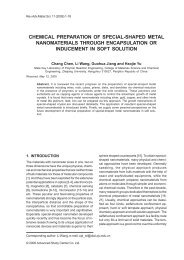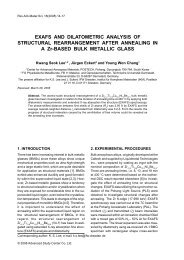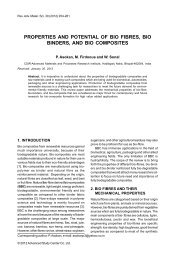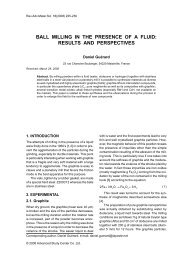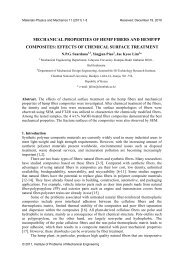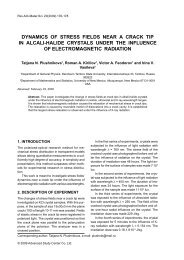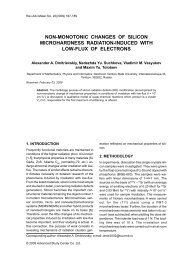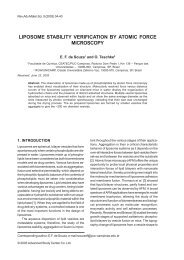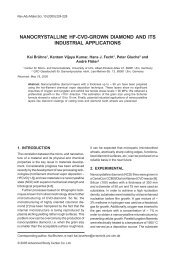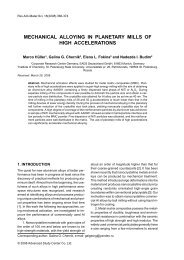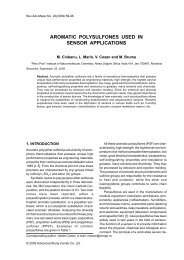surface pretreatment by phosphate conversion coatings – a review
surface pretreatment by phosphate conversion coatings – a review
surface pretreatment by phosphate conversion coatings – a review
Create successful ePaper yourself
Turn your PDF publications into a flip-book with our unique Google optimized e-Paper software.
152 T.S.N. Sankara Narayanan<br />
The concentration of the accelerators is also very<br />
important. Though increase in accelerator concentration<br />
favours better coating formation, too high concentration<br />
may cause passivation of metal <strong>surface</strong><br />
and inhibit the growth. When phosphating bath is<br />
modified <strong>by</strong> the addition of <strong>surface</strong> active agents,<br />
the concentration of accelerator should be optimized<br />
in accordance with the influence of these additives<br />
[286]. The iron content of the bath is also very critical.<br />
Although, a small quantity of iron salts favour<br />
<strong>phosphate</strong> precipitation (Break-in of the bath), the<br />
corrosion performance is largely affected as the fraction<br />
of the ferrous salts in the coating is increased<br />
[287]. The unfavourable effect of Fe(II) is usually<br />
decreased <strong>by</strong> the addition of complexing agents like<br />
Trilon B [288]. A method for controlling the iron content<br />
of zinc phosphating bath was proposed <strong>by</strong> Hill<br />
[289]. In the case of an iron phosphating bath, the<br />
ratio of ferrous to ferric iron in solution has been<br />
related to the tendency for flash rusting. The frequency<br />
and intensity of flash rust increases as the<br />
ratio of ferrous to ferric iron in solution decreased<br />
[290].<br />
Addition of specific compounds to the phosphating<br />
baths has also their own influence on phosphating.<br />
The incorporation of calcium ions in a zinc phosphating<br />
bath has resulted in a considerable change<br />
in the crystal structure, grain-size and corrosion<br />
resistance of the <strong>phosphate</strong> <strong>coatings</strong>. In fact, the<br />
structure of the zinc <strong>phosphate</strong> coating changes<br />
from the phosphophyllite-hopeite to schlozite-hopeite<br />
[291]. The reduction in grain-size (25 μm to 4 μm)<br />
and the improvement in the compactness of the<br />
coating and corrosion resistance, makes this kind<br />
of modification of zinc phosphating baths as an important<br />
type of phosphating and it has been classified<br />
as calcium-modified zinc phosphating [172].<br />
Similarly, the inclusion of manganese and nickel<br />
ions in the zinc phosphating bath proves to be useful<br />
in refining the crystal size and improving the corrosion<br />
resistance of the resultant <strong>phosphate</strong> <strong>coatings</strong>.<br />
It has been established that manganese and<br />
nickel modified zinc <strong>phosphate</strong> deposits on steel<br />
have an ordered structure and possess a high corrosion<br />
resistance [292]. The immense use of manganese<br />
and nickel ions in modifying the hopeite<br />
deposits obtained on galvanized steel in such a way<br />
that the modified hopeite deposit becomes equivalent<br />
to phosphophyllite to withstand the thermal and<br />
chemical aggressions, was very well established<br />
[293] and as a result of such a pronounced influence<br />
of the nickel and manganese ions, they have<br />
also been classified as nickel and manganese modi-<br />
fied zinc phosphating [172]. Moreover, such modifications<br />
have lead to the development of tri-cation<br />
phosphating baths consisting of zinc, manganese<br />
and nickel ions which explored its potential utility<br />
to <strong>phosphate</strong> aluminum, steel and galvanized steel<br />
using the same formulation [294-296]. Besides<br />
these major types of modifications, phosphating<br />
baths have experienced a variety of additives incorporated<br />
in the bath intended for a specific purpose.<br />
Each additive has its own influence on the<br />
phosphatability of steel depending upon the operating<br />
conditions [297-301]. Sankara Narayanan et al.<br />
[41] have classified the type of special additives used<br />
in phosphating and the purpose of their use. The<br />
favourable condition and the precautions in using<br />
these additives were recommended in the respective<br />
documents.<br />
Every phosphating bath reported in literature has<br />
a specific operating temperature and the baths were<br />
formulated in such a way that an equilibrium condition<br />
of the <strong>conversion</strong> of soluble primary <strong>phosphate</strong><br />
to insoluble tertiary <strong>phosphate</strong> exists at that temperature.<br />
Insufficient reach of temperature does not<br />
favour the precipitation of tertiary <strong>phosphate</strong> resulted<br />
from the <strong>conversion</strong>. However, when the baths were<br />
overheated above the recommended operating temperature,<br />
it causes an early <strong>conversion</strong> of the primary<br />
<strong>phosphate</strong> to tertiary <strong>phosphate</strong> before the<br />
metal has been treated and as a result increases<br />
the free acidity of the bath, which consequently<br />
delays the precipitation of the <strong>phosphate</strong> coating.<br />
Hence, in an operating line, which has operating<br />
time, this effect leads to the production of <strong>phosphate</strong><br />
<strong>coatings</strong> with a poor coating weight and inferior<br />
corrosion performance. Sankara Narayanan and<br />
Subbaiyan [302] have discussed the decisive role<br />
of overheating the phosphating baths and outlines<br />
the possible way of eliminating the difficulties encountered<br />
due to this problem.<br />
Likewise, every formulation has been assigned<br />
a fixed operating time based on the kinetics of the<br />
phosphating process using the particular bath followed<br />
<strong>by</strong> coating weight measurements or potential<br />
measurements with respect to the treatment<br />
time. It has been established <strong>by</strong> many workers that<br />
increasing the treatment time beyond the saturation<br />
point do not have any influence on the performance<br />
of the coating. But it has been warned that<br />
any attempt of reducing the treatment time to decrease<br />
the amount of <strong>phosphate</strong> deposition will be<br />
disasters.<br />
The method of deposition of <strong>phosphate</strong> coating<br />
or the phosphating methodology can influence the



